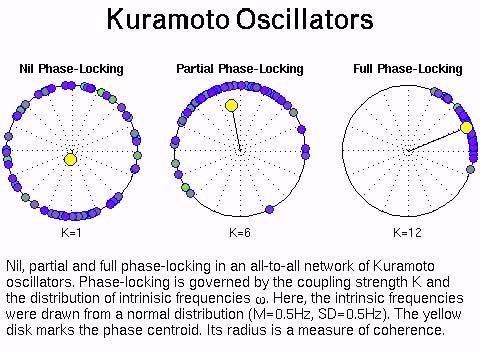 | ||
The Kuramoto model, first proposed by Yoshiki Kuramoto (蔵本 由紀 Kuramoto Yoshiki) , is a mathematical model used to describe synchronization. More specifically, it is a model for the behavior of a large set of coupled oscillators . Its formulation was motivated by the behavior of systems of chemical and biological oscillators, and it has found widespread applications such as in neuroscience . and oscillating flame dynamics. Kuramoto was quite surprised when the behavior of some physical systems, namely coupled arrays of Josephson junctions followed his model.
Contents
- Definition
- Transformation
- Large N limit
- Solutions
- Connection to Hamiltonian Systems
- Variations on the models
- Variations on topology
- Variations on the phase interaction
- References
The model makes several assumptions, including that there is weak coupling, that the oscillators are identical or nearly identical, and that interactions depend sinusoidally on the phase difference between each pair of objects.
Definition
In the most popular version of the Kuramoto model, each of the oscillators is considered to have its own intrinsic natural frequency
The most popular form of the model has the following governing equations:
where the system is composed of N limit-cycle oscillators, with phases
Noise can be added to the system. In that case, the original equation is altered to:
where
with
Transformation
The transformation that allows this model to be solved exactly (at least in the N → ∞ limit) is as follows. Define the "order" parameters r and ψ as
Here r represents the phase-coherence of the population of oscillators, and ψ indicates the average phase. Multiplying this equation with
Thus the oscillators' equations are no longer explicitly coupled; instead the order parameters govern the behavior. A further transformation is usually done, to a rotating frame in which the statistical average of phases over all oscillators is zero. That is,
Large N limit
Now consider the case as N tends to infinity. Take the distribution of intrinsic natural frequencies as g(ω) (assumed normalized). Then assume that the density of oscillators at a given phase θ, with given natural frequency ω, at time t is
The continuity equation for oscillator density will be
where v is the drift velocity of the oscillators given by taking the infinite-N limit in the transformed governing equation, i.e.,
Finally, we must rewrite the definition of the order parameters for the continuum (infinite N) limit.
Solutions
The incoherent state with all oscillators drifting randomly corresponds to the solution
When coupling K is sufficiently strong, a fully synchronized solution is possible. In the fully synchronized state, all the oscillators share a common frequency, although their phases can be different.
A solution for the case of partial synchronization yields a state in which only some oscillators (those near the ensemble's mean natural frequency) synchronize; other oscillators drift incoherently. Mathematically, the state has
for locked oscillators, and
for drifting oscillators. The cutoff occurs when
Connection to Hamiltonian Systems
The dissipative Kuramoto model is contained in certain conservative Hamiltonian systems with Hamiltonian of the form
After a canonical transformation to action-angle variables with actions
Hamilton's equation of motion become
and
So the manifold with
Variations on the models
There are two types of variations of models based on the original model presented above, one that deals with changing the topological structure of the model; the second are more related to models that are inspired by Kuramoto model but don't have the same functional form.
Variations on topology
Beside the original model, which has an all-to-all topology, a sufficiently dense complex network-like topology is amenable to the mean-field treatment used in the solution of the original model (see Transformation and Large N Limit above for more info). One also may ask for the behavior of models in which there are intrinsically local, like one-dimensional topologies which the chain and the ring are prototypical examples. In such topologies, in which the coupling is not scalable according to 1/N, it's not possible to apply the canonical mean-field approach, so one must relies upon case-by-case analysis, making use of symmetries whenever it is possible, which may give basis for abstraction of general principles of solutions.
Uniform synchrony, waves and spirals can readily be observed in two-dimensional Kuramoto networks with diffusive local coupling. The stability of waves in these models can be determined analytically using the methods of Turing stability analysis. Uniform synchrony tends to be stable when the local coupling is everywhere positive whereas waves arise when the long-range connections are negative (inhibitory surround coupling). Waves and synchrony are connected by a topologically distinct branch of solutions known as ripple. These are low-amplitude spatially-periodic deviations that emerge from the uniform state (or the wave state) via a Hopf birfurcation. The existence of ripple solutions was predicted by Wiley, Strogatz and Girvan who called them multi-twisted q-states.
Variations on the phase interaction
Kuramoto approximated the phase interaction between any two oscillators by its first Fourier component, namely
where parameters
